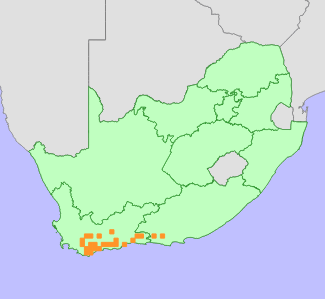|
Scientific Name | Diosma passerinoides Steud. |
Higher Classification | Dicotyledons |
Family | RUTACEAE |
Synonyms | Diosma obtusifolia Sond. |
National Status |
Status and Criteria | Vulnerable A2c; C2a(i) |
Assessment Date | 2012/07/31 |
Assessor(s) | D. Raimondo & V. Zikishe |
Justification | Total population size estimated to be <5000 mature individuals, based on records of 18 out of 25 subpopulations where species is indicated to be rare, uncommon, or only a few plants present, and with survey data of seven subpopulations indicating that the largest subpopulation consists of no more than 500 mature individuals. These populations are declining due to a number of different threats such as invasive alien plants, habit degradation in the form grazing and habitat loss due to protea cultivation. |
Distribution |
Endemism | South African endemic |
Provincial distribution | Eastern Cape, Western Cape |
Range | Robertson and Caledon to Bredasdorp, Albertinia and eastwards to the Baviaanskloof. |
Habitat and Ecology |
Major system | Terrestrial |
Major habitats | Central Ruens Shale Renosterveld, Agulhas Sand Fynbos, Elim Ferricrete Fynbos, Potberg Ferricrete Fynbos, Garden Route Granite Fynbos, North Outeniqua Sandstone Fynbos, South Outeniqua Sandstone Fynbos, Kouga Sandstone Fynbos, Breede Alluvium Renosterveld, Swellendam Silcrete Fynbos, Western Ruens Shale Renosterveld, Western Little Karoo, Eastern Ruens Shale Renosterveld, Mossel Bay Shale Renosterveld, Uniondale Shale Renosterveld, Langkloof Shale Renosterveld, Baviaanskloof Shale Renosterveld, Matjiesfontein Shale Renosterveld, Montagu Shale Renosterveld, Breede Shale Renosterveld, Ruens Silcrete Renosterveld |
Description | Dry clayish soils in renosterveld, associated with patches of silcrete. |
Threats |
| D. passerinoides is exposed to a variety of threats across its distribution range, such as competition from alien invasive plants, and habitat loss to expanding human settlements in which infrastructure development, grazing and crop cultivation play a major role. |
Population |
At least 30% population reduction estimated based on 40% habitat loss over three generations of this long-lived resprouter.
|
Population trend | Decreasing |
Assessment History |
Taxon assessed |
Status and Criteria |
Citation/Red List version | | Diosma passerinoides Steud. | VU C2a(i) | Raimondo et al. (2009) | | Diosma passerinoides Steud. | VU B1B2bcd | Victor (2002) | | Diosma passerinoides Steud. | Rare | Hilton-Taylor (1996) | | Diosma passerinoides Steud. | Rare | Hall et al. (1980) | |
Bibliography |
Goldblatt, P. and Manning, J.C. 2000. Cape Plants: A conspectus of the Cape Flora of South Africa. Strelitzia 9. National Botanical Institute, Cape Town.
Hall, A.V., De Winter, M., De Winter, B. and Van Oosterhout, S.A.M. 1980. Threatened plants of southern Africa. South African National Scienctific Programmes Report 45. CSIR, Pretoria.
Hilton-Taylor, C. 1996. Red data list of southern African plants. Strelitzia 4. South African National Botanical Institute, Pretoria.
Raimondo, D., von Staden, L., Foden, W., Victor, J.E., Helme, N.A., Turner, R.C., Kamundi, D.A. and Manyama, P.A. 2009. Red List of South African Plants. Strelitzia 25. South African National Biodiversity Institute, Pretoria.
Victor, J.E. 2002. South Africa. In: J.S. Golding (ed), Southern African plant Red Data Lists. Southern African Botanical Diversity Network Report 14 (pp. 93-120), SABONET, Pretoria.
Vlok, J. and Schutte-Vlok, A.L. 2010. Plants of the Klein Karoo. Umdaus Press, Hatfield.
|
Citation |
| Raimondo, D. & Zikishe, V. 2012. Diosma passerinoides Steud. National Assessment: Red List of South African Plants version 2024.1. Accessed on 2025/11/14 |
 Comment on this assessment
Comment on this assessment


